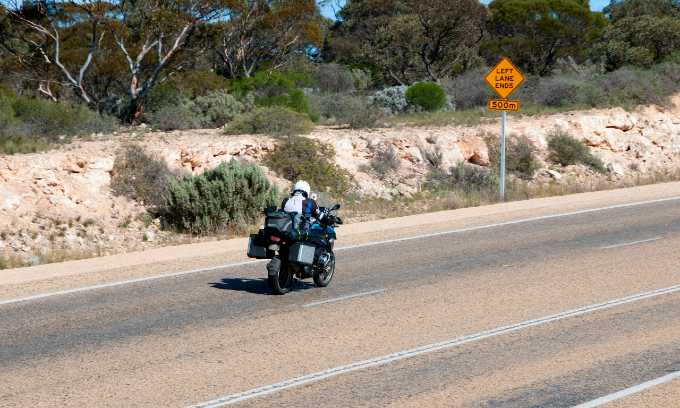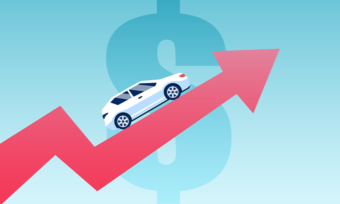What is motorcycle insurance?
Motorcycle insurance, like car insurance, is an insurance policy that can cover your bike against accidental damage to other people’s property, harm caused to other people, theft, fire or damage to your own bike. The type and amount of cover will depend on the policy you choose.
Types of motorcycle insurance
There are four main types of motorcycle insurance available on the market:
Compulsory third party (CTP)
You are required by law to have CTP insurance in order to register your motorcycle in Australia. All other insurance policies are optional. Depending on the state or territory, the cost of CTP insurance may be included as part of your annual vehicle registration, or you may need to organise your own CTP policy separately.
What it covers: CTP covers injuries caused by your motorcycle in at-fault accidents and compensates other people injured in these accidents. The specific conditions of this type of insurance are different from state to state.
What it doesn’t cover: CTP doesn’t cover the cost of repairs to your motorcycle or property, or anyone else’s vehicle(s) or property.
Third Party Property
This is the most basic form of optional motorcycle insurance cover.
What it covers: Third party property insurance covers the cost to repair damage caused by your motorcycle to other people’s property. It may also cover your legal costs if they decide to sue you over the damage that your motorcycle has caused.
What it doesn’t cover: Third party property doesn’t cover the cost of any repairs to or replacement of your own motorcycle.
Third Party, Fire and Theft
A level below comprehensive insurance that provides some level of protection for your motorcycle.
What it covers: Damage to the property of others, and damage to or loss of your own motorcycle from fire or theft will be covered. Some providers will have a limited cap on the amount of cover they will provide, much like car insurance. For example, a provider may cover your motorcycle up to its market value or an agreed value.
What it doesn’t cover: This insurance doesn’t cover the cost of repairs to your own motorcycle if it is involved in a traffic accident.
Comprehensive
Comprehensive motorcycle insurance provides you with the highest level of cover. However, it’s typically more expensive than other levels of cover.
What it covers: Comprehensive insurance will provide cover from risks such as accidental damage (both at-fault and not-at-fault), theft, third party property damage, vandalism, earthquakes, hail, storm and flood. If your motorcycle is written off, your insurer may compensate you by paying the market value or agreed value of your motorcycle, or by providing a replacement, depending on the policy. These policies are generally also valid in the event of an accident where the motorcycle’s rider is not a nominated rider.
Optional extras may also be available, ranging from cover for helmet and riding gear, choice of repairer, and a rental hire after an accident. To compare costs check out the Canstar comprehensive insurance comparison tool.
What it doesn’t cover: Some exclusions on cover include, but are not limited to, incidents that occur when under the influence of alcohol, drugs or medication, if the motorcycle is not roadworthy and if it is used for business purposes.
Inclusions: what does comprehensive motorcycle insurance cover?
Comprehensive insurance policies across the market in Australia will typically cover:
Accidental damage
If your motorcycle is damaged during an accident, insurance providers will typically repair your motorcycle or compensate you for the cost of repairs you organise yourself. The maximum amount that could be paid would either be your agreed sum insured amount, or your motorcycle’s current market value.
If the motorcycle has been damaged beyond repair and has been registered for less than 12 or 24 months (the specification differs between insurance providers), the provider may give you the choice of receiving a replacement motorcycle or the sum insured amount.
Providers also usually cover costs associated with an accident, such as towing, clean-up of debris, emergency expenses such as accommodation and travel, replacing damaged keys or locks, and repair of a trailer attached to your bike at the time of the accident.
Theft
If your motorcycle has been stolen, there are certain steps to follow when making a claim for theft, just like if your car has been stolen. The insurer will typically ask for a police report number and other details involving the incident. Some policies may have a waiting period before action is taken to allow time for police to search for your bike.
In order to be covered for theft, you typically must secure your motorcycle when left unattended. This can be storing your bike in a garage, locked shed or locking your wheel if you plan to leave it in the open. Also, most insurance policies won’t cover incidents where the bike was stolen while being shown or test ridden for sale and you weren’t present. This is the same for incidents where the key was left in the ignition of an unattended motorcycle.
Attempted theft
An attempted theft or your motorcycle may involve damage to your bike, its locks and keys, and the place where you are storing it. Comprehensive motorcycle insurance often covers these types of incidents, but you will typically need a police report to claim for attempted theft.
Damage caused by uninsured drivers
If you are in a collision with a vehicle whose driver is uninsured, your insurance provider will generally pay to repair the damage to your motorcycle. Just like car insurance, most providers will cover the damage up to the sum insured amount while some have lower caps, and you may have to pay excess.
Natural disasters (storm, hail, flood, and earthquakes)
Your motorcycle could be damaged by a natural disaster, such as storms, hail, floods, or earthquakes. Storm damage can include rainwater that runs across the surface of the land or road, overflows from storm water drains or overflows from pools and spas. Hail damage is usually covered under storm damage, although many insurance providers do not list it specifically.
The definition of what constitutes a ‘flood’ for the purposes of providing car insurance can vary from provider to provider. This is the same for cyclones, where you may only be covered for instances of damage from an officially named cyclone. It’s worth checking exactly what you will and will not be covered for in the product disclosure statement (PDS) and target market determination (TMD) for your policy before you purchase the cover.
Fire or explosion
Fire and explosion insurance covers everything from your fuel tank catching fire, to your motorcycle being burned by a bushfire or grassfire. Fire damage is covered by comprehensive and third party fire and theft insurance policies.
Vandalism or malicious damage
Vandalism or malicious damage means wilful and deliberate acts of damage to a motorcycle. If such an incident occurs, it’s recommended that you report this to the police or relevant authorities as soon as possible. Insurance providers may ask for a police incident number if you make a claim for your motorcycle under vandalism or malicious damage.
Additional inclusions or optional cover
The following additional inclusions can be found in standard policies, or offered as optional extra cover for an add-on cost by insurers:
Riding gear (safety clothing)
Riding gear is clothing and protective safety items that are designed for motorcycle riding and worn by you, such as helmets, gloves, jackets, pants and riding boots.
This cover can be included in comprehensive motorcycle insurance, but some providers only offer it as an optional add-on. The amount of cover for riding gear can vary between providers, so check your policy.
Replacement of keys and locks
If your motorcycle is stolen or maliciously damaged, it will need to have its keys and locks replaced and re-coded so that it cannot be stolen again. This optional extra often also covers you for when you’ve lost or misplaced your key.
Choice of repairer
The majority of insurance providers typically only allow you to repair any claimed damages at a partnered repairer. Adding a choice of repairer to your insurance policy allows you to choose where your motorcycle is repaired.
Accident hire car
Accidental car hire is an inclusion where the insurance provider will arrange a hire vehicle for you when your motorcycle is being repaired (and you are without a transport vehicle). Although often offered as an optional extra, some comprehensive insurance policies may already include rental car hire for not-at-fault accidents in its base policy.
Motorcycle trailer or sidecar
Not all motorcycle insurance policies automatically cover a trailer or sidecar. If it’s not part of the policy, it will typically be offered as an add-on for those with a motorcycle trailer or sidecar that they wish to insure.
Exclusions: what comprehensive motorcycle insurance doesn’t cover
When it comes to comprehensive motorcycle insurance policies across the market in Australia, they will typically not cover:
Under the influence
You will not be covered for any incidents that occur when the motorcycle is being ridden by or controlled by anyone who is under the influence of alcohol, drugs, or medications that affect their ability to control the motorcycle.
Business use
You will generally not be automatically covered for any incidents that occur if your motorcycle is being used for business or commercial purposes. This includes using your motorcycle for hire, rider instructions, or taking passengers or delivering goods for payment. It also includes using your motorcycle to carry hazardous, toxic or flammable goods in quantities larger than allowed by regulation. Some insurers may offer a separate form of business insurance cover that applies to motorcycles being used for commercial purposes, or as an add-on to their standard policy.
Illegal or unauthorised modifications
You will generally not be covered if any non-manufacturer modification has been made to your motorcycle that is not street legal, roadworthy or approved by the transport department in your state or territory. If you’re looking to modify your motorcycle, it’s best to contact your insurance provider directly to see if it will affect your cover.
Motor sports or off-road riding
You will typically not be covered for any incidents that occur while you are using or testing your motorcycle in preparation for any motor sports, or using your motorcycle on motorcycle or dirt bike tracks.
Which type of motorcycle insurance should you have?
Your choice of policy can be influenced by a range of factors specific to your situation. Here are some factors that you may want to consider:
Budget
Choosing the insurance that’s right for you will largely depend on your budget. Generally, the more cover you want, the more you’ll need to pay in premiums. You could consider taking out the highest level of insurance cover that you can afford, while ensuring the risks being covered are relevant to your bike, location and riding habits. It’s worth weighing up the insurance premium payable and comparing policies against how much you can afford in the event of an accident or repairs. Keep in mind that, even when you’re insured, you will often still need to pay an excess when making a claim. Ensure that you read any important documents provided by the insurance provider before signing up, including the Product Disclosure Statement (PDS) and the Target Market Determination (TMD).
The bike’s age
With a shiny new two-wheeled machine, it may make sense to have a high level of cover to reflect the potential financial loss should the bike be damaged. If you have finance on your motorcycle, some lenders will require you to take out comprehensive cover. As your motorcycle gets older, however, you might begin to weigh up the value of the motorcycle and the cost of doing repairs against the cost of comprehensively insuring it.
Cover image source: Adwo/Shutterstock.com








